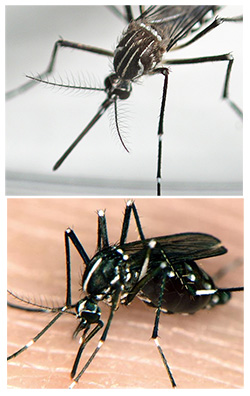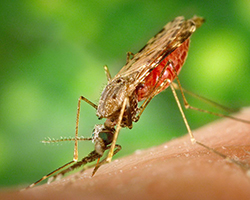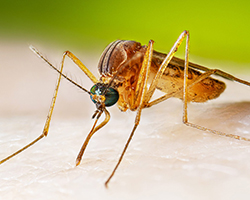How Many Mosquito Species Are There?
Did you know there are more species of mosquitoes than there are dog breeds? It’s true - there are about 3,500 different mosquito species worldwide, while there are only about 200 different dog breeds. Luckily, not all mosquitoes are known to transmit diseases. Less than 3% of mosquitoes (about 90 species) are known to transmit disease. Additionally, less than 10% of mosquitoes are thought to be able to transmit disease.
This includes mostly only three mosquito genera (out of 112): Aedes, Anopheles, and Culex. The species that transmit diseases are called "vectors." Vector mosquito species may differ widely in their habitats, life cycle, what they look like, and how they behave. Let’s learn some of the unique characteristics of each of the three mosquito genera that include most of those species.
Which Types of Mosquitoes Can Carry Disease?
Behavior:Aedes mosquitoes are most active during the day and are known as “day-biters”. Ae. aegypti mosquitoes prefer to bite humans, while other Aedes mosquitoes also bite other animals.

Habitat: Aedes live in a variety of climates that range from tropical to temperate. They can live indoors and outdoors and prefer to live close to humans or other animals that they can feed on.
Species that transmit diseases: There are at least five different Aedes species that transmit diseases. These include Ae. aegypti and Ae. albopictus.
Life cycle:Aedes most often lay eggs in artificial containers, such as tires, buckets, or plant pots. The eggs can survive several months without water. After these eggs get wet, they will hatch and adult mosquitoes will emerge 7 - 12 days later.
Appearance:Aedes are black and white in color. The patterns on their bodies can be useful to identify species. For example, Ae. aegypti have several white lines down their backs, while Ae. albopictus have a thick white line down their backs.
Aedes mosquitoes include the species known as the yellow fever mosquito (Ae. aegypti) and the Asian tiger mosquito (Ae. albopictus).
Behavior:Anopheles mosquitoes are most active in the evenings and during the night. They are easy to identify when they sit on the wall, as they rest at an angle to the wall. They look a little like a miniature dart arrow that has been thrown into the wall! Most other mosquitoes rest parallel to the surfaces they rest on.

Habitat:Anopheles live in a variety of climates that range from tropical to temperate. They most often lay eggs in swamps, ponds, lakes, streams, rice fields, or other natural and still bodies of water.
Species that transmit diseases: There are over 30 Anopheles species that we know of that transmit malaria (of the total 430 Anopheles species). The main malaria vector is a subspecies of An. gambiae.
Life cycle:Anopheles females may prefer human or cattle blood; this varies with species. Some species almost only feed on humans. After a blood meal, they lay all of their eggs on the water’s surface. Within 8-16 days, adult mosquitoes will emerge from the eggs.
Appearance:Anopheles are mostly dark brown in color and are lighter brown and blackish on various parts of their bodies.
One species of Anopheles is known as the common malaria mosquito.
Behavior: Culex are most active during the night and fly into homes and take a blood meal while people are sleeping. Culex also often feed on birds, which can result in the transmission of the West Nile virus (WNV).
Habitat:Culex live all around the world except in the extreme northern areas where it is very cold. They prefer to lay eggs in “dirty” still water such as storm drains, green pools, or septic tanks. They are also found breeding in artificial containers such as tires.

Species that transmit diseases: There are about 20 different Culex species that transmit diseases. Some of the main disease vector species include Cx. pipiens, and Cx. tarsalis.
Life cycle:Culex females will feed on people and other animals. They then lay their eggs on stagnant water, with the eggs stuck together to make an “egg raft”. Within 9 - 14 days, adult mosquitoes will emerge from the developed eggs.
Appearance: Most Culex are overall brownish, but some have an iridescent color. Some Culex are black with some white banding on certain body parts like their proboscis and legs.
Some Culex species are known as common house mosquitoes.
What Other Kinds of Mosquitoes Are There?
It's easy to only wonder about the specific mosquito species that can carry diseases. But mosquito diversity goes far beyond that. There are over 3,000 species of mosquito that may not carry any diseases. And there are even some species of mosquito that might be called beautiful.

Additional images via Wikimedia Commons. Image of Aedes mosquito on purple flower petal by CDC.
Read more about: All About Mosquitoes
Bibliographic details:
- Article: Mosquito Species
- Author(s): Dr. Biology
- Publisher: Arizona State University School of Life Sciences Ask A Biologist
- Site name: ASU - Ask A Biologist
- Date published:
- Date accessed:
- Link: https://askabiologist.asu.edu/mosquito-species
APA Style
Dr. Biology. (). Mosquito Species. ASU - Ask A Biologist. Retrieved from https://askabiologist.asu.edu/mosquito-species
Chicago Manual of Style
Dr. Biology. "Mosquito Species". ASU - Ask A Biologist. . https://askabiologist.asu.edu/mosquito-species
Dr. Biology. "Mosquito Species". ASU - Ask A Biologist. . ASU - Ask A Biologist, Web. https://askabiologist.asu.edu/mosquito-species
MLA 2017 Style

Mosquitoes can be dangerous, but they can also be beautiful. Take a peek at some of the most dangerous and most beautiful species of mosquitoes.
Be Part of
Ask A Biologist
By volunteering, or simply sending us feedback on the site. Scientists, teachers, writers, illustrators, and translators are all important to the program. If you are interested in helping with the website we have a Volunteers page to get the process started.

